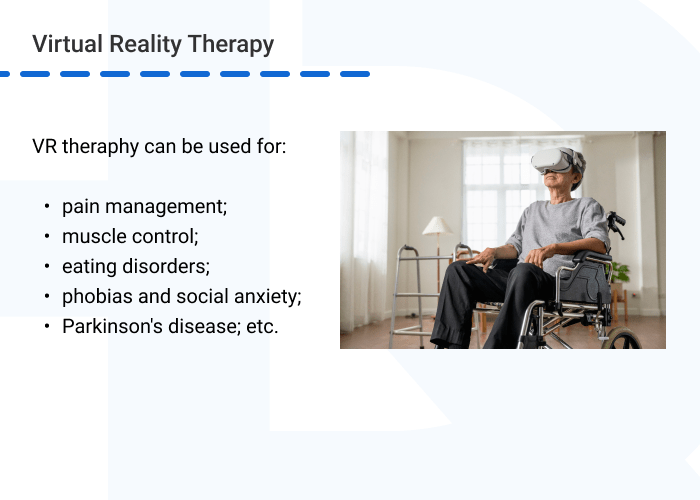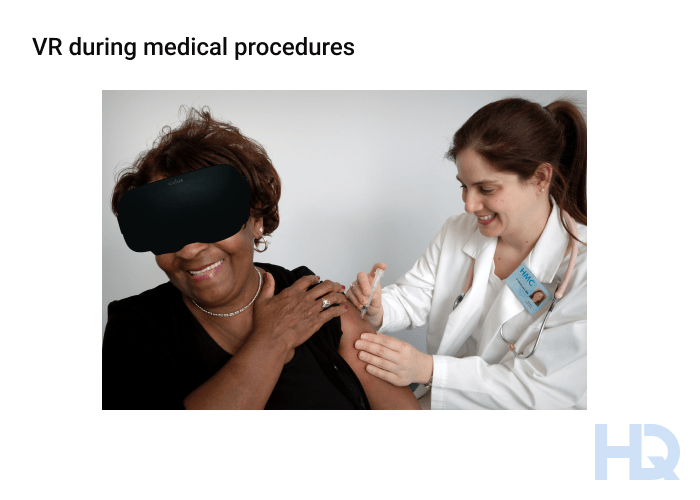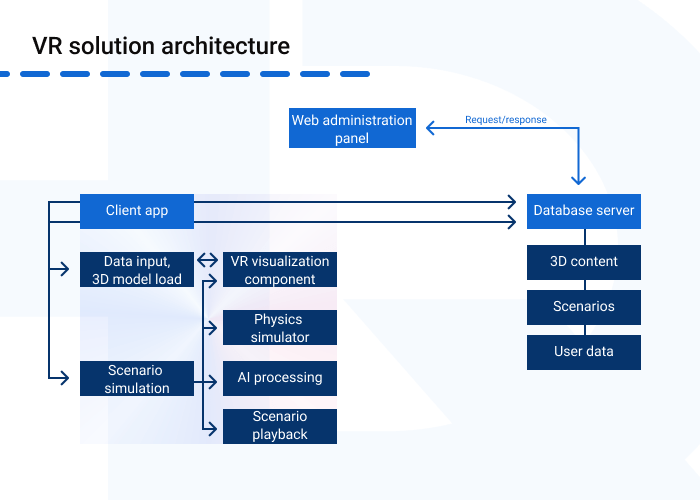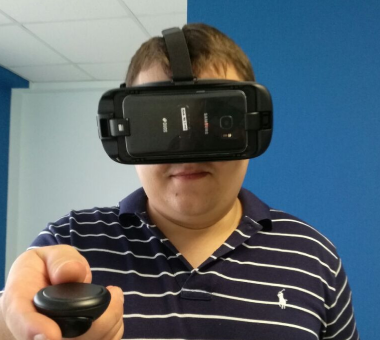Virtual Reality for Pain Management
Technologies for Creating VR Pain Management Solutions
Examples of Using VR for Pain Management
Current Challenges and Future Outlook of VR in Pain Management
Cutting-edge technologies such as Virtual Reality are already making a difference in many industries – VR apps create additional value for customers. In healthcare, VR software contributes significantly to the quality of medical care and rehabilitation. It’s predicted that the VR healthcare market will reach $6.2 billion in 2029.
With the ability of VR to transfer and fully immerse users in a virtual environment, the technology is an excellent method of distracting patients with chronic and acute pain. Although the first attempts to implement Virtual Reality for pain management date back to the 1990s, the technology in this field is still relatively new and drawing more and more attention from the medical community and software providers.
In this article, we’ll discuss some of the many possibilities for applying VR to improve pain management.
Virtual Reality for Pain Management
Technologies for Creating VR Pain Management Solutions
Examples of Using VR for Pain Management
Current Challenges and Future Outlook of VR in Pain Management
Virtual Reality is a modern technology that moves users into a completely new reality and provides a unique virtual experience. VR can be used for psychological and occupational therapy as well as improved virtual rehabilitation.
To explore VR, patients usually need a VR headset, which gives a 360° view of the 3D virtual environment. The therapy may also involve additional devices such as motion controllers or wired gloves to enhance the VR experience.
Virtual Reality therapy isn’t like teletherapy; it goes beyond Zoom meetings and immerses patients in a virtual world. However, VR therapy involves a trained therapist that controls the use of the technology during treatment.
Cases using VR during treatment include:

In this article, we will focus on pain management and explore how to use VR to enhance it.
The main objective of VR in pain management is to reduce pain perception. Virtual Reality helps achieve a decrease in pain intensity under the hypothesis of active distraction. With its high level of immersion and engagement, VR is more efficient than traditional distraction methods, as it fully captures the patient’s attention and takes them away from reality. It’s assumed that pain reduction may be the result of direct or indirect sensory influence on pain-signaling pathways.
Another theory of the analgesic effect of VR is “gate control.” According to the theory, pain signals pass through the nervous system and encounter “gates” in the spinal cord. Non-painful distractions block “gates,” preventing the pain signal from reaching the brain, so a patient can’t feel it.
Despite possible side effects such as motion sicknesses, nausea, and dizziness, Virtual Reality for pain relief can be considered a complementary or even alternative pain therapy to pharmacological treatment, e.g. opioids, and be used for various types of pain.
Virtual Reality for chronic pain management aims to calm a person rather than distract them. Therefore, patients are most often transported to relaxing virtual simulations, such as а field with green grass and a blue sky or seaside with soothing surf. The images can be accompanied by other features, for example breathing exercises, sounds, voice guiding, etc.
All these techniques focus on helping patients control their mood, reduce stress, and exchange negative thoughts for positive ones. This is needed because stress and anxiety intensify pain, while inner calm and control of emotions make it easier to tolerate.
Another way of using VR for chronic pain is to assist patients who are afraid to move for fear that this will cause additional pain. In this case, VR offers gentle exercises for affected body parts to keep muscles in tune.
Now, there aren’t many studies that clearly confirm or reject the effectiveness of VR for chronic pain relief. But existing reports do show results in a small group of people. For example, one study reported positive outcomes in reducing chronic low back pain with Virtual Reality.
Interested in VR for pain management? Let’s discuss it!HQSoftware has a team of skilled professionals ready to tackle the project.
Anna Halias
Business Development Manager,
HQSoftware
Since pain draws full human attention, shifting the focus to external stimuli slows down the response to pain signals.
Therefore, in acute pain, healthcare specialists use VR to take patients’ attention away from reality to reduce pain perception while performing medical manipulations, for example, while dressing patients with burns.
Another case where VR for pain management has proven itself is in reducing the pain of laboring women. According to systematic research, during normal labor VR helps reduce women’s anxiety, increase their satisfaction, and enhance pain management.
So far, the effectiveness of using VR for acute pain has been confirmed by many studies. For example, one reported pain reduction in 88% of patients who used Virtual Reality for pain relief. Another study cited a 39% decrease in opioid use in patients who had VR pain therapy.
By using cognitive distractions during medical procedures, healthcare specialists can reduce the pain level and perform operations on more emotionally stable patients. And games, memory tasks, and interaction with avatars can be helpful during repeated procedures like chemotherapy.
Repeating procedures that have already caused discomfort can increase the patient’s suffering, negatively affecting the effectiveness of the treatment. VR, as an element of distraction and relaxation, helps patients endure their procedures more easily and creates positive associations to help cope with stress and anxiety.

Some treatments, including medications, may not work for patients with mental health conditions such as depression. This necessitates the use of alternative approaches. In depression treatment, VR can be deployed in immersive cognitive behavioral therapy, telemedicine sessions, to create a safe virtual environment for avatar-to-avatar sessions, and other activities.
Virtual Reality may also help patients deal with anxiety, phobias, and PTSD. By entering a safe virtual environment, patients can interact with frightening stimuli and situations until their stress and fear are reduced. For example, individuals with fear of heights may be placed in a virtual glass elevator 20 stories high.
What helps patients is the understanding that if the experience becomes overwhelming, they can stop it at any moment. In this way, individuals can relive the same situation over and over again, overcoming fears step by step.
It’s difficult for kids to cope with pain on their own, so VR for pain management can be a game-changing solution. In addition, fear of procedures such as blood tests can cause additional pain subconsciously.
For example, if a child is afraid of intravenous access, they may refuse to give a hand willingly or make it more difficult for a nurse to reach into the vein. The procedure may then require more attempts, which brings additional pain and increased anxiety. This, in turn, can create more negative associations in a kid and affect the success of future procedures. If the child’s experience is traumatic, it may also lead to skipped appointments.
VR, especially VR games, are being actively used not only for reducing pain perception but also for decreasing anxiety and stress before procedures. Their positive effect is described in several studies. For example, the JAMA Network Open study confirms that Virtual Reality helps decrease pain and anxiety during intravenous catheter placement.
In children, VR therapy for pain management also helps avoid the use of drugs, which may be more addictive to children than adults.
To summarize, VR in pain management has two main goals: to distract or calm a patient with full or partial immersion in the virtual environment. But is it always necessary to use a special headset, especially if a person isn’t feeling well in it? To answer this question it’s necessary to understand how VR solutions are actually used in pain management.
How do modern businesses use AR to increase their revenues and outperform their industry competitors?

The first thing to know is that there are 3 main types of VR applications for pain management:
It’s not always necessary to have a VR headset to access the virtual environment. The choice of devices depends on the goals of the solution and the level of immersion required. Therefore, VR devices for chronic pain reduction include:
VR application architecture also depends on its type, as well as third-party integrations, servers, etc. But there are still 3 basic components included in every VR solution:

The most commonly used technologies for VR solutions for pain management, as well as the hardware devices, are listed in the table below.
| VR engines, frameworks, libraries | Unity, Unreal Engine, Oculus SDK, Oculus Quest 1,2, iOS/Android SDK, Web VR, React VR, Google VR |
| 2D/3D design | Autodesk Maya, Blender, Autodesk 3ds Max, Substance Painter, Photoshop |
| Front-end | HTML, JavaScript, Vue js, Angular, React, C++, C# |
| Back-end | Python, Java, .NET, Java, Go, Node.js, PHP |
| Clouds Services | Google Cloud Platform, Microsoft Azure, Amazon Web Services |
| Databases | MySQL, Microsoft SQL Server, Azure SQL Database, Oracle, PostgreSQL, MongoDB |
| Hardware | Google Cardboard/Daydream, PlayStation VR, Oculus, VIVE |
The most studied area of applying VR for pain relief is burn wound care. One pioneering application, “SnowWorld”, was created at the University of Washington Harborview Burn Center. The app takes patients to an icy virtual world where they are able to play snowballs with snowmen and penguins. The game requires VR goggles; users need to slightly turn their head toward a character and press a button to make a throw.
The game distracts patients from pain during wound care, as they are fully immersed in the virtual environment. Such an approach also helps avoid painful flashbacks that patients may experience as they look at their wounds. The effectiveness of VR for burn treatment is also confirmed by some studies that claim patients experience a 35-50% reduction in pain using VR.
Another example of VR for pain relief is RelieVRx (formerly EaseVRx), an immersive VR system that uses behavioral methods such as cognitive behavioral therapy to reduce the intensity of chronic lower back pain. The system is designed for self-care at home and includes a VR headset, controller, and breathing amplification device to guide patients during breathing practices.
The system offers exercises based on established principles of behavioral therapy, including relaxation, focus shifting, distraction, self-compassion, etc. In November 2021, the U.S. Food and Drug Administration (FDA) approved the marketing and distribution of RelieVRx, with preliminary studies conducted beforehand. The results showed that 66% of patients who used RelieVRx reported a 30% pain decrease and 46% of patients reported a 50% reduction.
Many hospitals and medical centers are already implementing VR solutions for pain management. Among them are the Hospital for Special Surgery in New York, Hoag Hospital in Newport Beach, Boston’s Children Hospital, etc. In addition to the positive effect of reducing pain perception and improving patients’ well-being, VR also brings an economic effect. Statistics say that using VR therapy for pain can save a hospital between $11 and $150 per patient. The reason for this is that medical facilities are able to use less opioids and reduce hospital length of stay.
The figures indicate that medical institutions can already benefit greatly from using Virtual Reality. This predicts active adoption of the technology in the future.
For now, we can’t say that Virtual Reality for pain relief has become mainstream. The reason is that the medical community is continuing to research the effectiveness of the technology. Current results are promising, however. For example, one study showed a reduction of acute pain in 88% of patients. In addition, VR technology is becoming more affordable to implement and costs less than it did 5-10 years ago.
Concerns about rapid addiction to opioids, especially among children, are also pushing the medical community to turn to alternative therapy, including Virtual Reality. In the future, we can expect to see VR pain treatment kits that patients can freely use at home to deal with their pain.
Strict requirements and standards in healthcare are other challenges for new VR applications. For example, VR solutions need to comply with HIPAA to ensure the privacy and security of patients’ personal information. Passing all the compliance controls can take plenty of time, which slows down the widespread implementation of the technology. Therefore, the FDA aims to create methods for managing and approving future VR products as soon as they’re developed.
To get approval as fast as possible, a VR solution must meet all regulations related to the medical, hardware, and software aspects. To ensure the quality of the software, companies need either a strong development team or to turn to experienced software providers.
With a variety of skilled specialists and more than 9 years of experience in AR/VR development, HQSoftware is a trusted partner able to provide you with technical consulting as well as assist in the development of a comprehensive VR pain management system.
With our expertise and capacity, we can help you choose a technology stack, build architecture design, allocate required specialists to extend your in-house team, or deliver a full development cycle on our side. Contact us to get a consultation and learn more about how we can support you in leveraging Virtual Reality for pain management.

AR/VR Expert
A developer with extensive expertise in AR/VR, very ingrained into the topic of Mixed Reality development. Shares his knowledge and the results of many years of work.
We are open to seeing your business needs and determining the best solution. Complete this form, and receive a free personalized proposal from your dedicated manager.

Sergei Vardomatski
Founder